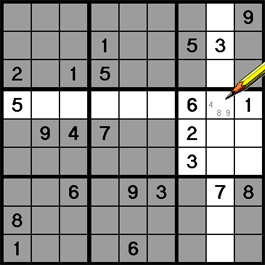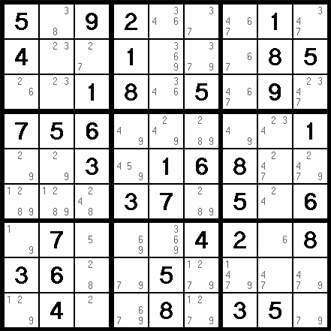

A note on Pencil MarksUntil now, the techniques I have covered do not require any "note taking". You have solved cells by simply scanning with your eyes. But if you find yourself with a puzzle that is not yet complete, and you no longer see any "Open Singles" or numbers you can fill in using "Visual Elimination," then you will need to move on to Pencil Marks.
Although the act of making pencil marks itself is not a technique per se, it is something that is required for all of the rest of the Sudoku solving techniques. In a nutshell, pencil marking is writing little numbers as a way of keeping track of the remaining possibilities, or candidates, for all the cells that are still unsolved. The idea is that you would then logically and methodically remove those marks, or candidates, one by one. Here's how you do it: Find an empty cell. Look at all the numbers in that cell's row, column, and block. Grab a pencil (so you can erase), and lightly write all the numbers that are still possible inside the cell. In other words, write all the numbers 1 through 9 except those that already appear in that same row, column, or block. These are all the cell's "candidates". Once you have filled in a cell, move on to the next, and repeat the process for all the empty cells.  What you are basically doing is taking notes. You do not know what number actually goes in that cell, but you have it narrowed down to a list of candidates, and you are noting these candidates so you can see them at a glance. What you are basically doing is taking notes. You do not know what number actually goes in that cell, but you have it narrowed down to a list of candidates, and you are noting these candidates so you can see them at a glance.
It is very important, though, that you write all the possible candidates in a cell before moving on. Don't go through first and do all the 1s, then the 2s, etc — because if you get distracted (if the phone rings or something), you may end up with some unfinished cells. Do one cell at a time, and finish that cell before moving on. I recommend writing the "pencil marks" very lightly. I also like to always put them in in the same uniform order: 1, 2, & 3 go across the top; 4, 5, & 6 across the middle, and 7, 8, & 9 along the bottom. Even if I am only writing 2 or three marks, I put them in their usual spots. This makes it easier to see identical pairs of them later.
If you would like to skip using actual pen, pencil, and paper, there are several good computer programs out there for working on Sudoku puzzles. These programs do everything from creating new puzzles for you, to acting as a virtual worksheet, complete with virtual pencil and pen, and even helping you solve them step by step. My personal favorite, hands down, is "Sudoklue" (//www.sudoklue.com). It does just about anything you want and is very versatile. In fact, I used Sudoklue to create the screenshots you see on this site. Once you have all the pencil marks filled in, your puzzle will look something like this:
For the most part, the rest of the Sudoku solving techniques I will teach you do not actually solve a cell, but instead they remove pencil marks, using logic. This is called "candidate elimination". The goal is to get every unsolved cell down to one possibility (one pencil mark). When you have done this, you have solved the puzzle! I think you'll find the logic we can use in the techniques to follow both challenging and satisfying. Remember, each cell only has one correct answer. Nothing feels better than to find those answers logically, using tried and true methods!
|






